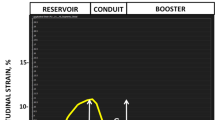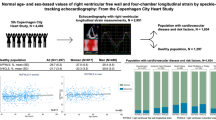Abstract
Objective
This study aims to accurately evaluate the cardiac structure and function of the frail population in elderly patients with normal ejection fraction (EF) using the 3D volume quantification and speckle tracking of echocardiography, to explore the correlation between frailty and cardiac structure and function.
Methods
A total of 350 elderly aged 65 and above in-patients, excluding those with congenital heart disease, cardiomyopathy, and severe valvular heart disease, were included in the study. Patients were divided into non-frail, pre-frail, and frail group. Echocardiography techniques including speckle tracking and 3D volume quantification, were used to analyze the cardiac structure and function of the study subjects. Comparative analysis was statistically significant if P < 0.05.
Results
The cardiac structure of the frail group was different compared with non-frail patients, the frail group demonstrated increased left ventricular myocardial mass index (LVMI), but decreased stroke volume. Cardiac function was also impaired in the frail group: reservoir strain and conduit strain of left atrium, strain of right ventricular (RV) free wall, strain of RV septum, 3D EF of RV, and global longitudinal strain of LV were significantly decreased. Frailty was significantly and independently associated with LV hypertrophy (OR 1.889; 95% CI 1.240,2.880; P = 0.003), LV diastolic dysfunction (OR 1.496; 95% CI 1.016,2.203; P = 0.041), left ventricular global longitudinal strain (LVGLS) reduction (OR 1.697; 95% CI 1.192, 2.416; P = 0.003), and reduced RV systolic function (OR 2.200; 95% CI 1.017, 4.759; P = 0.045).
Conclusion
Frailty is closely associated with several heart structural and functional alterations, which not only manifested as LV hypertrophy and reduced LV systolic function, but also decreased LV diastolic function, RV systolic function, and left atrial systolic function. Frailty is an independent risk factor for LV hypertrophy, LV diastolic dysfunction, LVGLS reduction, and reduced RV systolic function.
Trial registration number
ChiCTR2000033419. Date of registration: May 31, 2020.



Similar content being viewed by others
Data availability
The datasets used during the current study are available from the corresponding author on reasonable request.
References:
Bergman H, Ferrucci L, Guralnik J et al (2007) Frailty: an emerging research and clinical paradigm–issues and controversies. J Gerontol A Biol Sci Med Sci 62:731–737
Krumholz HM (2013) Post-hospital syndrome–an acquired, transient condition of generalized risk. N Engl J Med 368:100–102
Damluji AA, Chung S-e, Xue Q-L et al (2021) Frailty and cardiovascular outcomes in the national health and aging trends study. European Heart J 42:3856–3865
Afilalo J, Alexander KP, Mack MJ et al (2014) Frailty assessment in the cardiovascular care of older adults. J Am Coll Cardiol 63:747–762
Newman AB, Gottdiener JS, McBurnie MA et al (2001) Associations of subclinical cardiovascular disease with frailty. J Gerontol A Biol Sci Med Sci 56:M158-166
Topriceanu CC, Moon JC, Hardy R et al (2021) Longitudinal birth cohort study finds that life-course frailty associates with later-life heart size and function. Sci Rep 11:6272
Kane AE, Bisset ES, Heinze-Milne S et al (2021) Maladaptive changes associated with cardiac aging are sex-specific and graded by frailty and inflammation in C57BL/6 mice. J Gerontol A Biol Sci Med Sci 76:233–243
Gharacholou SM, Tashiro T, Cha SS et al (2015) Echocardiographic indices associated with frailty in adults ≥ 65 years. Am J Cardiol 116:1591–1595
Hwang AC, Liu LK, Lee WJ et al (2015) Association of frailty and cardiometabolic risk among community-dwelling middle-aged and older people: results from the I-lan longitudinal aging study. Rejuvenation Res 18:564–572
Nadruz W Jr, Kitzman D, Windham BG et al (2017) Cardiovascular dysfunction and frailty among older adults in the community: the ARIC study. J Gerontol A Biol Sci Med Sci 72:958–964
Frisoli A Jr, Ingham SJ, Paes ÂT et al (2015) Frailty predictors and outcomes among older patients with cardiovascular disease: data from fragicor. Arch Gerontol Geriatr 61:1–7
Fried LP, Tangen CM, Walston J et al (2001) Frailty in older adults: evidence for a phenotype. J Gerontol A Biol Sci Med Sci 56:M146-156
Gomez-Ambrosi J, Silva C et al (2012) Body mass index classification misses subjects with increased cardiometabolic risk factors related to elevated adiposity. Int J Obes (Lond) 36:286–294
Gomez-Ambrosi J, Silva C et al (2012) Clinical usefulness of a new equation for estimating body fat. Diabetes Care 35:383–388
DeSchutter A, Lavie CJ, Milani RV et al (2011) Body composition and survival in stable coronary heart disease: impact of lean mass index and body fat in the “obesity paradox.” J Am College Cardiol. https://doi.org/10.1016/S0735-1097(11)60956-X
Nagueh SF, Smiseth OA, Appleton CP et al (2016) Recommendations for the evaluation of left ventricular diastolic function by echocardiography: an update from the american society of echocardiography and the european association of cardiovascular imaging. J Am Soc Echocardiogr 29:277–314
Marwick TH, Gillebert TC, Aurigemma G et al (2015) Recommendations on the use of echocardiography in adult hypertension: a report from the European association of cardiovascular imaging (EACVI) and the American society of echocardiography (ASE)dagger. Eur Heart J Cardiovasc Imaging 16:577–605
Zaidi A, Knight DS, Augustine DX et al (2020) Echocardiographic assessment of the right heart in adults: a practical guideline from the British society of echocardiography. Echo Res Pract 7:G19–G41
Tan AX, Shah SJ, Sanders JL et al (2021) Association between myocardial strain and frailty in CHS. Circ Cardiovasc Imaging 14:e012116
Pavasini R, Cardelli LS, Piredda A et al (2021) Diastolic dysfunction, frailty and prognosis in elderly patients with acute coronary syndromes. Int J Cardiol 327:31–35
Kusunose K, Okushi Y, Yamada H et al (2018) Prognostic value of frailty and diastolic dysfunction in elderly patients. Circ J 82:2103–2110
Jansen HJ, Moghtadaei M, Rafferty SA et al (2021) Atrial fibrillation in aging and frail mice: modulation by natriuretic peptide receptor C. Circ Arrhythm Electrophysiol 14:e010077
Canteri AL, Gusmon LB, Zanini AC et al (2019) Sarcopenia in heart failure with reduced ejection fraction. Am J Cardiovasc Dis 9:116–126
Walston J, McBurnie MA, Newman A et al (2002) Frailty and activation of the inflammation and coagulation systems with and without clinical comorbidities: results from the cardiovascular Health Study. Arch Intern Med 162:2333–2341
Cesari M, Penninx BW, Pahor M et al (2004) Inflammatory markers and physical performance in older persons: the InCHIANTI study. J Gerontol A Biol Sci Med Sci 59:242–248
Schaap LA, Pluijm SM, Deeg DJ et al (2009) Higher inflammatory marker levels in older persons: associations with 5-year change in muscle mass and muscle strength. J Gerontol A Biol Sci Med Sci 64:1183–1189
Travison TG, Nguyen AH, Naganathan V et al (2011) Changes in reproductive hormone concentrations predict the prevalence and progression of the frailty syndrome in older men: the concord health and ageing in men project. J Clin Endocrinol Metab 96:2464–2474
Schaap LA, Pluijm SM, Deeg DJ et al (2008) Low testosterone levels and decline in physical performance and muscle strength in older men: findings from two prospective cohort studies. Clin Endocrinol (Oxf) 68:42–50
Barzilay JI, Blaum C, Moore T et al (2007) Insulin resistance and inflammation as precursors of frailty: the cardiovascular health study. Arch Intern Med 167:635–641
Boirie Y (2009) Physiopathological mechanism of sarcopenia. J Nutr Health Aging 13:717–723
Funding
This study was supported by National Clinical Research Center for Geriatrics, West China Hospital, Sichuan University (Z20192010).
Author information
Authors and Affiliations
Corresponding author
Ethics declarations
Conflict of interest
All authors declare they have no conflict of interest to disclose.
Ethics approval and consent to participate
This study was conducted in accordance with the declaration of Helsinki. This study was conducted with approval from the Ethic committee of West China Hospital, Sichuan University.
Consent for publication
Written informed consent to publish the clinical details and images of the patient was obtained.
Additional information
Publisher's Note
Springer Nature remains neutral with regard to jurisdictional claims in published maps and institutional affiliations.
Rights and permissions
Springer Nature or its licensor (e.g. a society or other partner) holds exclusive rights to this article under a publishing agreement with the author(s) or other rightsholder(s); author self-archiving of the accepted manuscript version of this article is solely governed by the terms of such publishing agreement and applicable law.
About this article
Cite this article
Xi, L., Xuemei, Z., Ling, Y. et al. Correlation between frailty and cardiac structure and function in echocardiography in elderly patients with normal ejection fraction. Aging Clin Exp Res 35, 775–784 (2023). https://doi.org/10.1007/s40520-023-02363-5
Received:
Accepted:
Published:
Issue Date:
DOI: https://doi.org/10.1007/s40520-023-02363-5




